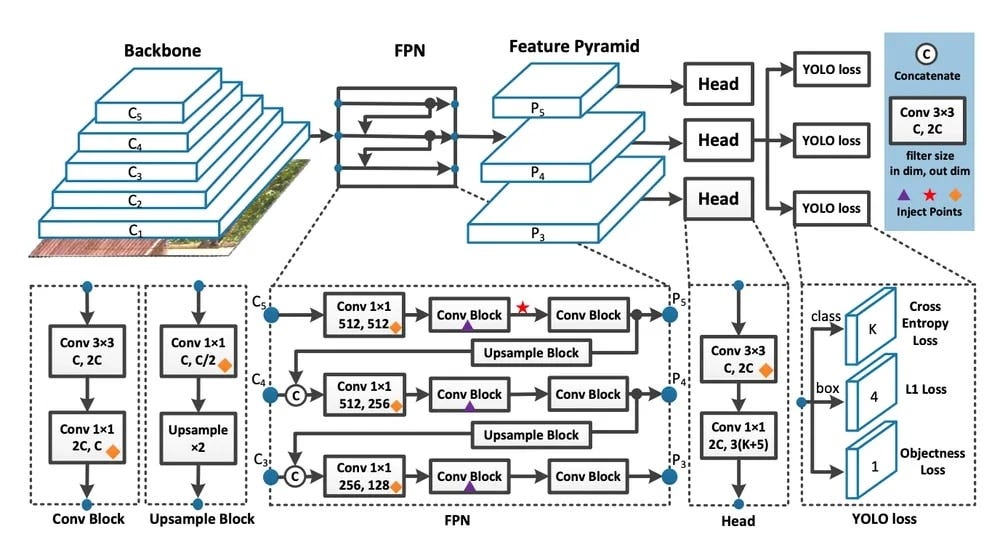YOLOv8: Overview
Contents
- 1. Introduction
- 2. YOLOv8 Architecture
- 3. Key Advantages
- 4. Practical Applications
- 5. Example Usage of YOLOv8 with Ultralytics
- 6. References
1. Introduction
YOLOv8 is the latest version in the YOLO family, renowned for its fast detection speed and high accuracy in real-time object detection. YOLOv8 improves upon previous versions thanks to architectural enhancements and training algorithm optimizations.
2. YOLOv8 Architecture
YOLOv8 consists of three main components: Backbone, FPN (Feature Pyramid Network), and Head. This design enables the model to efficiently handle both large and small objects in images.
2.1 Backbone and Head
Backbone:
Extracts features from the input image. YOLOv8 typically uses the CSP (Cross Stage Partial) architecture or its improved variants. The input image passes through Conv layers and CSP blocks, producing feature maps (C_3, C_4, C_5) at different abstraction levels.- FPN (Feature Pyramid Network):
An intermediate layer that combines features from multiple levels (deep to shallow) to preserve both semantic and detailed information. The FPN process includes:- Channel reduction via 1x1 Conv
- Upsampling and concatenation of features from previous layers
- Sequential Conv layers to refine features
- Head:
Receives multi-scale features (P3, P4, P5) from the FPN and predicts:- Bounding box coordinates (x, y, w, h)
- Objectness confidence score
- Class probabilities
2.2 Main Workflow
YOLOv8 is a One-Stage Detector, meaning it simultaneously performs region proposal and object classification in a single step.
Specifically:
- The input image is processed through the backbone to extract features.
- Features pass through the FPN to generate multi-scale feature maps.
- Each feature map (P3, P4, P5) is fed into the head for prediction (bounding boxes, class, and objectness).
Compared to two-stage models like Faster R-CNN (which propose regions first then classify), YOLOv8 is much faster and particularly effective in real-time scenarios such as:
- Security surveillance
- Autonomous vehicles
- Embedded AI devices
3. Key Advantages
- Fast processing speed, suitable for real-time applications.
- High accuracy, especially with small objects.
- Easy to train and deploy.
- Simple yet highly effective architecture.
- Supports easy training with PyTorch and Ultralytics.
4. Practical Applications
- Security surveillance.
- Product counting and classification in manufacturing.
- Object detection on autonomous vehicles.
- Sports video analysis.
- Industrial robots and UAVs.
5. Example Usage of YOLOv8 with Ultralytics
You can directly view usage examples of YOLOv8 in the official Ultralytics documentation below:
If the iframe does not display, you can open the page directly at:
🔗 https://docs.ultralytics.com/models/yolov8/#yolov8-usage-examples
6. References
[1] S. Ren, K. He, R. Girshick, J. Sun. Faster R-CNN: Towards Real-Time Object Detection with Region Proposal Networks. arXiv:1506.01497v3 [cs.CV], 2016. 🔗 https://arxiv.org/abs/1506.01497
[2] Glenn Jocher, Ayush Chaurasia, Jing Qiu. Ultralytics YOLOv8. Version 8.0.0, released 2023. Licensed under AGPL-3.0. 🔗 https://github.com/ultralytics/ultralytics
[3] Ultralytics. YOLOv8 Documentation. 🔗 https://docs.ultralytics.com/models/yolov8/


